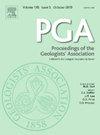Dissolution as the origin of soft-sediment deformation structures in the Upper Cretaceous of the Noumerat area (Oued Mya Basin, Algerian Sahara)
IF 1.3
4区 地球科学
Q2 Earth and Planetary Sciences
引用次数: 0
Abstract
This study presents the first evidence of soft-sediment deformation structures (SSDS) within Upper Cretaceous lagoonal deposits of the Noumerat area, formed as a result of dissolution processes. Sulphates, particularly anhydrite, are well known for their susceptibility to karstification, with dissolution commonly reported as the origin of collapse breccia. However, this research introduces not only as the origin of breccia but also as a trigger for a variety of SSDS. These deformation features are primarily associated with the dissolution of anhydrite in Noumerat sedimentary succession, located on the Mzab Plateau in the Northern Algerian Sahara. As the anhydrite dissolved, the overlying claystones subsided into collapse troughs, accompanied by lateral sliding, forming distorted structures such as dome-like folds, water-escape structures, and slump structures. Furthermore, the presence of faults and cracks within the anhydrite layers significantly accelerated dissolution, promoting the formation of breccia fragments within the karst system. This underscores the chemical instability and rapid dissolution of anhydrite. The presence of secondary gypsum-bearing claystones, along with evidence of unconformity, and unconformities further supports this interpretation.
阿尔及利亚撒哈拉Oued Mya盆地Noumerat地区上白垩统软沉积变形构造的溶蚀成因
本研究首次提供了在努默拉特地区上白垩统泻湖沉积物中存在软沉积变形构造(SSDS)的证据,这些软沉积变形构造是由溶解作用形成的。硫酸盐,特别是硬石膏,因其易受岩溶作用而闻名,溶蚀通常被报道为塌陷角砾岩的成因。然而,本研究不仅介绍了角砾岩的成因,还介绍了角砾岩的多种成因。这些变形特征主要与位于阿尔及利亚撒哈拉北部Mzab高原的Noumerat沉积序列中硬石膏的溶解有关。随着硬石膏的溶解,上覆的粘土滑脱成塌陷槽,并伴有侧向滑动,形成圆顶褶皱、泄水构造、滑塌构造等变形构造。此外,硬石膏层内断层和裂缝的存在显著加速了溶蚀作用,促进了岩溶系统内角砾岩碎片的形成。这强调了硬石膏的化学不稳定性和快速溶解。次生含石膏粘土岩的存在,以及不整合面和不整合面的证据进一步支持了这一解释。
本文章由计算机程序翻译,如有差异,请以英文原文为准。
求助全文
约1分钟内获得全文
求助全文
来源期刊
CiteScore
2.70
自引率
8.30%
发文量
54
审稿时长
6-12 weeks
期刊介绍:
The Proceedings of the Geologists'' Association is an international geoscience journal that was founded in 1859 and publishes research and review papers on all aspects of Earth Science. In particular, papers will focus on the geology of northwestern Europe and the Mediterranean, including both the onshore and offshore record. Following a long tradition, the PGA will focus on: i) a range of article types (see below) on topics of wide relevance to Earth Sciences ii) papers on aspects of Earth Science that have societal relevance including geoconservation and Earth management, iii) papers on palaeoenvironments and palaeontology of the Mesozoic and Cenozoic, iv) papers on aspects of Quaternary geology and climate change, and v) papers on the history of geology with particular reference to individuals that have shaped the subject. These topics will also steer the content of the themes of the Special Issues that are published in the PGA.

 求助内容:
求助内容: 应助结果提醒方式:
应助结果提醒方式:


